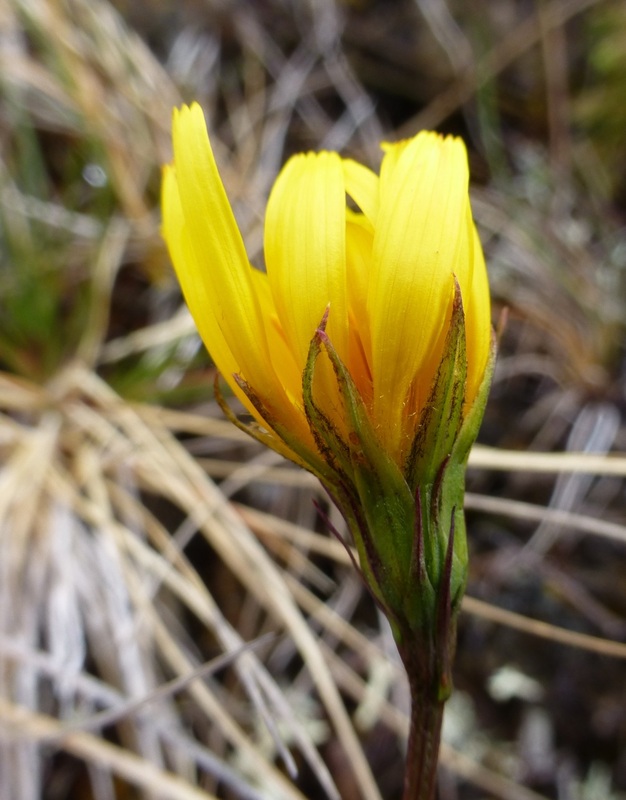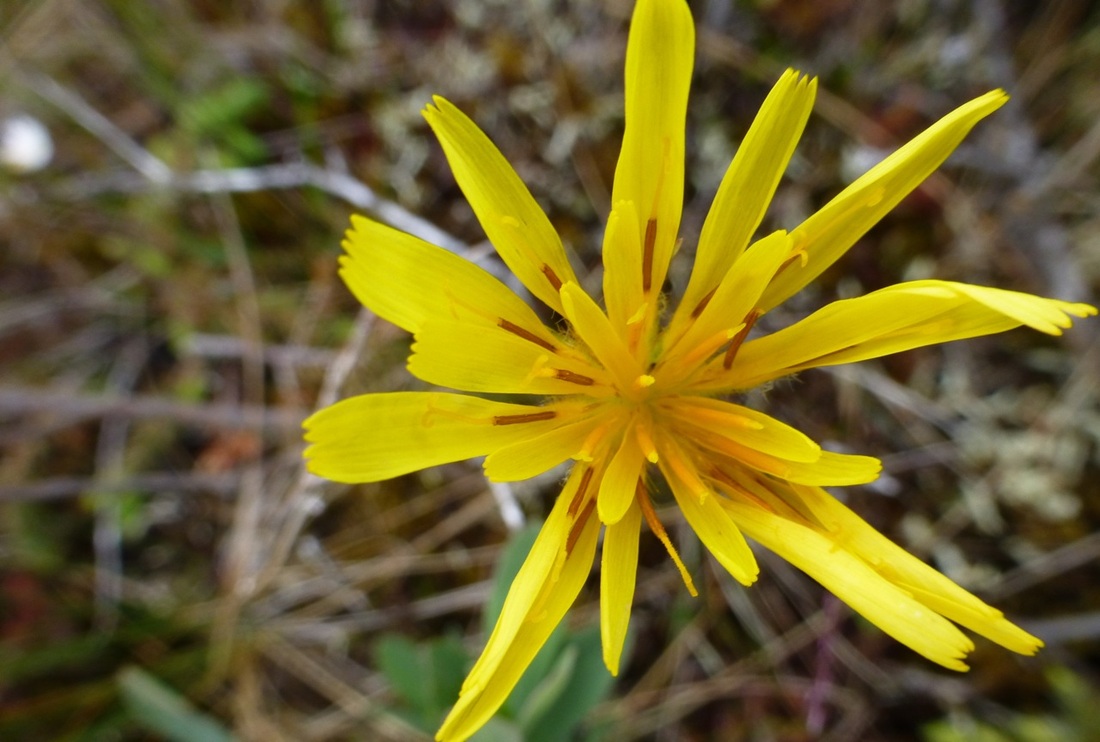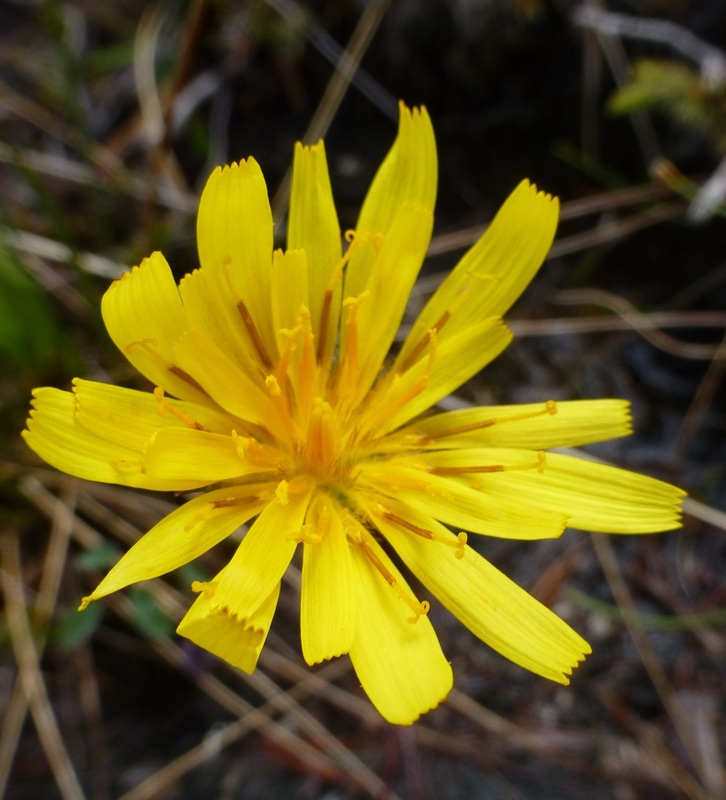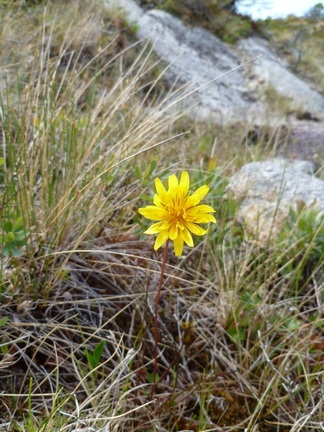Apargidium • Microseris borealis, Apargidium boreale
{Apargidium = resembling the genus Apargia also known as Leontodon, meaning 'lion tooth'; Micro = small, seris = chicory}
Identification
Apargidium is a hairless, taprooted perennial species. Each plant produces one stem with a single terminal flower. The stems reach 50 cm tall and are mostly hairless and bare, though they may occasionally bear one or two small bracts. Apargidium stems leak a milky juice when broken, as do other species of the genus and similar species such as the common dandelion. The leaves are all basal, are long (to 25 cm) and narrow with a lance or lance-oblong shape, and vary from smooth to slightly toothed or lobed (click here to view an illustration). The yellow ray flowers are somewhat dandelion-like but with far fewer petals. The 10-13 mm long involucral bracts surrounding the flower (visible in the bottom left photo) are layered in several rows. This plant produces a head of fruits in the form of 4-8 mm long bristled brown achenes.
Habitat & Range
Apargidium grows in wet habitats from low to subalpine elevations, including sphagnum bogs, wet meadows and rocky slopes. It is a common species in coastal BC, and its range stretches north to Alaska and south to northern California.
Similar Species
Apargidium is the only species of its genus found on the Central Coast; a handful of other Mircoseris species are found in certain areas of southern BC. Apargidium's terminal yellow ray flower is somewhat similar to the common dandelion flower (along with the flowers of other species in the dandelion genus, Taraxacum), though the two should not be easily confused as dandelion flowers have many more petals. The dandelion's leaves are also wider, and one dandelion plant can produce multiple flowering stems.
iNaturalist
https://www.inaturalist.org/taxa/78035-Microseris-borealis
Apargidium is a hairless, taprooted perennial species. Each plant produces one stem with a single terminal flower. The stems reach 50 cm tall and are mostly hairless and bare, though they may occasionally bear one or two small bracts. Apargidium stems leak a milky juice when broken, as do other species of the genus and similar species such as the common dandelion. The leaves are all basal, are long (to 25 cm) and narrow with a lance or lance-oblong shape, and vary from smooth to slightly toothed or lobed (click here to view an illustration). The yellow ray flowers are somewhat dandelion-like but with far fewer petals. The 10-13 mm long involucral bracts surrounding the flower (visible in the bottom left photo) are layered in several rows. This plant produces a head of fruits in the form of 4-8 mm long bristled brown achenes.
Habitat & Range
Apargidium grows in wet habitats from low to subalpine elevations, including sphagnum bogs, wet meadows and rocky slopes. It is a common species in coastal BC, and its range stretches north to Alaska and south to northern California.
Similar Species
Apargidium is the only species of its genus found on the Central Coast; a handful of other Mircoseris species are found in certain areas of southern BC. Apargidium's terminal yellow ray flower is somewhat similar to the common dandelion flower (along with the flowers of other species in the dandelion genus, Taraxacum), though the two should not be easily confused as dandelion flowers have many more petals. The dandelion's leaves are also wider, and one dandelion plant can produce multiple flowering stems.
iNaturalist
https://www.inaturalist.org/taxa/78035-Microseris-borealis
References
Microseris borealis (Bong.) Sch. Bip. In Klinkenberg, Brian. (Ed.). E-Flora BC: Electronic Atlas of the Plants of British Columbia. Lab for Advanced Spatial Analysis, Department of Geography, University of British Columbia, Vancouver. Accessed 06/10/2013.
Pojar, J. and MacKinnon, A. (1994). Plants of Coastal British Columbia. Vancouver, BC: Lone Pine Publishing. P. 271.
Authors and editors of page
Kelly Fretwell and Brian Starzomski (2013).
Microseris borealis (Bong.) Sch. Bip. In Klinkenberg, Brian. (Ed.). E-Flora BC: Electronic Atlas of the Plants of British Columbia. Lab for Advanced Spatial Analysis, Department of Geography, University of British Columbia, Vancouver. Accessed 06/10/2013.
Pojar, J. and MacKinnon, A. (1994). Plants of Coastal British Columbia. Vancouver, BC: Lone Pine Publishing. P. 271.
Authors and editors of page
Kelly Fretwell and Brian Starzomski (2013).








